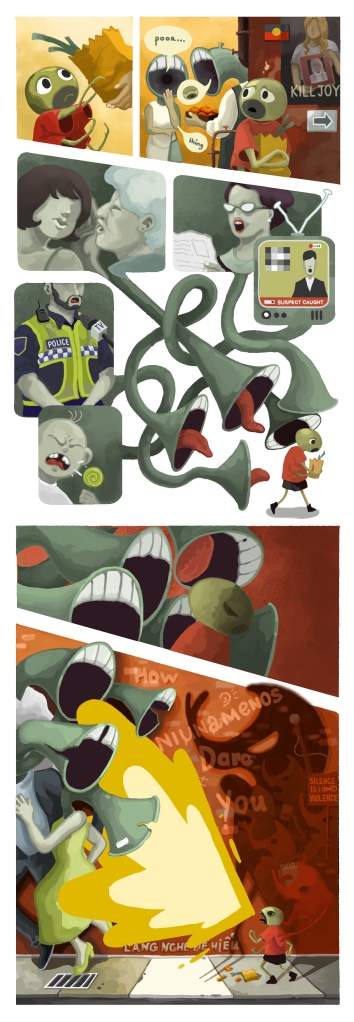When it happened, everyone knew. Some people were gracious about it, others not so much: ‘Where are YOUR parents?’ Also, when meeting new people… For many years, I didn’t know how to talk about it. I always got the same reaction: shock or disbelief.
I was there when it happened, so I went through so much of Court: ‘You’re here to tell the truth,’ they said. But I was just learning to talk, let alone understand all those big words. And I remember bouncing from counsellor to counsellor. I spent so long just telling the story of what happened, that we never got into how to move forward. And it was just exhausting. I can roll it off my tongue and it just sounds like I’m making it up.
You know, knowledge is power. But growing up, I didn’t know what to believe about the homicide. I always felt I was missing a part of the puzzle. I started asking questions. I got shut down. Everything was so taboo. I gathered all the information I could to form my own opinion. There came a point where I went, ‘My life is literally a true crime podcast but no one talks about it.
Nope, I AM talking about it. I’m standing up for what I believe in. This was the extreme end of family violence. Like it or not, that’s what it was.’
How the hell do you compact years of trauma? It is hard to talk and relive it, it is still quite raw. But the more I talk about my life, I find it a lot easier. You know, I went through that trauma, but look at where I am now. How do I tell my story? As an empowering story. Mum’s memory lives on in sharing that story, helping others survive. I still worry what my family will think. But what if me talking helps another person? Then bugger them, the bigger picture is we’ve got to make a better future. But it’s always gonna be the hardest thing I’ll ever have to do.
I’m 16… She’s never going to see me graduate. She’s never gonna see me pass my driving license. She’s never gonna be there when a boy breaks my heart.
Now it’s been more than 20 years. One part of me is that story. I no longer need to tell the story to justify anything anymore.
But now my kids want to know why they never met grandma.
With much care, Kati Marinkovic Chavez created this composite narrative based on our research interviews about the loss of a parent due to domestic homicide.
A key element of Kati’s analysis was how bereaved young people were confronted with stigma and unhelpful narratives by others. Suggestions that they had been too young to remember or comprehend what happened. That they were damaged beyond repair. That they were doomed, destined to become a victim or perpetrator themselves. Or that they should be ‘over it’ by now.

These imposed narratives continued well into adulthood, and our participants described ways in which they rebelled against those narratives. Kati’s article about it is well worth reading.
It’s one of 8 brief articles about the findings of our research among 70 people with lived, caregiving or professional experience of parental domestic homicide, across Australia, the UK and Ireland, with a focus on Australia. Together with a talented illustrator and people with lived experience we also visualised the findings, with a little rhino beetle as the central character.
In addition to the experiences of stigma and silencing above, we found an absence of child-centred approaches; a deep impact on home life with support for caregivers being rare; only partially realised potential for trauma-informed care within the school context; and a lack of coordinated and evidence-based (mental health) support.
Our participants had several suggestions to improve the situation. We formulated these priority actions (more detail in the report):
- Record the data. We recommend that state and territory governments systematically record the number of children bereaved by each domestic homicide, and audit subsequent service involvement.
- Include bereaved children explicitly in domestic homicide inquests and investigations. This should include a review of services provided to children in the aftermath of the homicide, up until the date of the inquest/investigation.
- Provide a coordinated, multi-agency, outreaching support response in the direct aftermath of a domestic homicide.
- Provide accessible, tailored trauma- and grief-focused mental health treatment in the aftermath of domestic homicide and beyond.
- Provide support for caregivers to help them understand and connect with children dealing with traumatic grief and stigma, as well as practical, financial and mental health support.
- Make available a dedicated team of trained (mental health) specialists who can provide consultation to schools, services and individual professionals supporting families in the immediate aftermath and in the long-term after domestic homicide.
- Provide guidance materials for child protection, mental health, legal and education professionals regarding the needs of children and wider family bereaved by domestic homicide.
- Intensify efforts to ensure that schools are trauma-informed, involving teachers, support staff and leadership, providing an understanding and supportive school environment
- Facilitate the establishment and maintenance of dedicated peer support groups, for children, young people and adults who have been bereaved by domestic homicide.
- Involve people with lived experience in the design of service improvements and establishment of new initiatives, and facilitate opportunities to contribute to de-stigmatisation.
- Ensure that a child rights-based, child-centred approach is at the heart of all aspects of post-homicide support provided by professionals and important adults in children and young people’s lives.
The brief report has more information (and more illustrations!)
If you see an opportunity to share the report with policy makers or practitioners in your network, our team would be very grateful.
Yes, the last post on this blog was a year ago! Aptly called ‘slowing down’… These days, the blog is more an archive of past musings, with an occasional new addtion.



